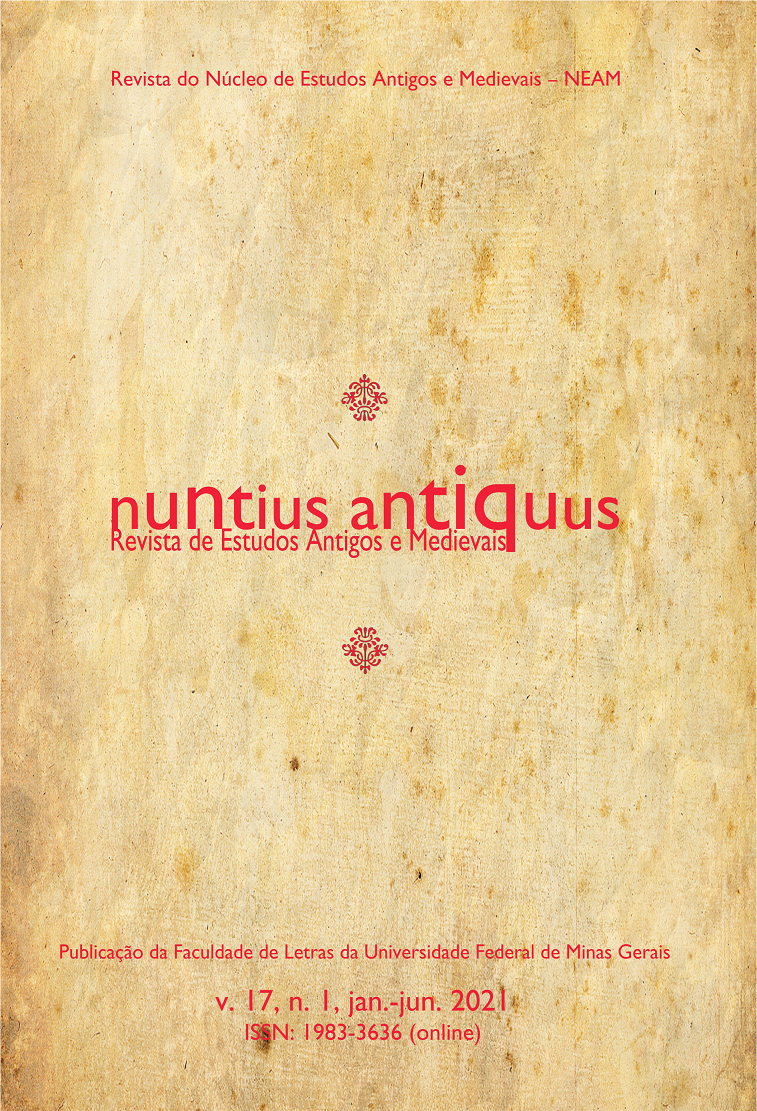Como surgiram as orações substantivas em latim?
Análise sobre o estudo de Durham a partir de outras perspectivas
Palabras clave:
língua latina, Plauto, sintaxe, pragmática, linguística históricaResumen
Este artigo tem como objetivo revisitar a metodologia empregada por Durham (1901) para descrever a origem das orações substantivas de subjuntivo, a partir do latim de Plauto. Seu objetivo era encontrar exemplares plautinos que pudessem figurar um suposto estágio paratático da língua, do qual teria surgido a hipotaxe em latim. Sendo sua metodologia pouco detalhada e precisa, visou-se aprofundá-la e especificá-la, utilizando instrumental de teorias linguísticas não disponíveis à época, notadamente os conceitos de enunciação, atos de fala e teoria pragmática no geral. Concluiu-se que algumas condições de “harmonização” entre dois verbos paratáticos precisariam ser cumpridas para que o expediente de Durham fosse executado, a fim de se explicar como dois verbos em parataxe podem ser reanalisados em hipotaxe. O artigo segue com algum criticismo sobre o pressuposto de um estágio paratático do latim, algo fundamental à teoria dele. Por fim, uma brevíssima exposição de outra possível abordagem sobre o conjunto de dados por ele recolhido é apresentada, uma visão sincrônica, quantitativa e distribucional.
Descargas
Citas
ALLEN, J. H.; GREENOUGH, J. B. New Latin Grammar. Boston; London: Ginn & Company, 1903.
ANTOINE, F. De la parataxe et de l’hypotaxe dans la langue latine. Revue des Études Anciennes, Bordeaux, v. 1, n. 1, p. 27-46, 1899. DOI: https://doi.org/10.3406/rea.1899.1124.
BALDI, P. The Foundations of Latin. Berlin: Mouton de Gruyter, 2002. DOI: https://doi.org/10.1515/9783110807110.
BENNETT, C. E. Syntax of Early Latin. Hildesheim: Georg Olms, 1982 [1910-1914]. v. 2. em 1.
BENVENISTE, É. L’appareil formel de l‘énonciation. In: BENVENISTE, É. Problèmes de linguistique générale, 2. [S. l.]: Gallimard, 2014. p. 79-90.
BRUGMANN, K. Grundriss der vergleichenden Grammatik der indogermanischen Sprachen. Einleitung und Leutlehre. Wortbildungslehre. Strassburg: Karl J. Trübner, 1886-1892. v. 2.
BUCK, C. D. A Grammar of Oscan and Umbrian. Boston: The Athenaeum Press, 1904.
CART, A. et al. Grammaire Latine. [S. l.]: Nathan, 2007 [1955].
CLACKSON, J.; HORROCKS, G. The Blackwell History of the Latin Language. Malden, MA; Oxford: Wiley-Blackwell, 2011 [2007].
DE VAAN, M. Etymological Dictionary of Latin and the Other Italic Languages. Leiden; Boston: Brill, 2008. (Leiden Indo-European Etymological Dictionary Series, v. 7).
DELBRÜCK, B. Vergleichende Syntax der indogermanischen Sprachen. Strassburg: Karl J. Trübner, 1893-1900. 3 v. (Grundriss der vergleichenden Grammatik der indogermanischen Sprachen). DOI: https://doi.org/10.1515/9783111600550.
DICKEY, E. The Rules of Politeness and Latin Request Formulae. In: PROBERT, P.; WILLI, A. (ed.). Laws and Rules in Indo European. Oxford: Oxford University Press, 2012. p. 313-328. DOI: https://doi.org/10.1093/acprof: oso/9780199609925.003.0017.
DURHAM, C. L. The Subjunctive Substantive Clauses in Plautus, not Including Indirect Questions. Ithaca, NY: Cornell University Press, 1901. (Cornell Studies In Classical Philology, v. 13). Disponível em: http://hdl.handle.net/2027/
mdp.39015035972697. Acesso em: 1 out. 2020.
ERNOUT, A.; MEILLET, A. Dictionnaire Étymologique de la Langue Latine. Histoire des mots. Paris: Klincksieck, 2001.
FORTSON, B. W. Indo-European Language and Culture: An Introduction. 2. ed. Malden; Oxford: Blackwell, 2010.
HOFMANN, J. B.; SZANTYR, A. Lateinische Syntax und Stilistik. München: C. Beck, 1965.
LIMA, R. Gramática Normativa da Língua Portuguesa. Rio de Janeiro: José Olympio, 2014.
LINDSKOG, C. Quaestiones de parataxi et hypotaxi apud priscos latinos. Lundae: Möller, 1896.
MAZZANTI JR., A. With or without ut? Full Evidence of Subjunctive Complementation of facio in Archaic Latin. Transactions of the Philological Society, v. 118, n. 1, p. 79-93, 2020. DOI: https://doi.org/10.1111/1467-968X.12167.
MORPURGO DAVIES, A. Karl Brugmann and Late Nineteenth-Century Linguistics. In: BYNON, T.; PALMER, F. R. (ed.). Studies in the History of Western Linguistics. In Honour of R. H. Robins. Cambridge: Cambridge University Press, 1986. Disponível em: http://www.ling-phil.ox.ac.uk/files/amd_brugmann_and_late_19th_c._linguistics_1986.pdf. Acesso em: 1 out. 2020.
PINKSTER, H. Oxford Latin Syntax. Volume 1: The simple clause. Oxford: Oxford University Press, 2015. DOI: https://doi.org/10.1093/acprof:oso/9780199283613.001.0001.
POKORNY, J. Indogermanisches Etymologisches Wörterbuch. Bern; München: Francke Verlag, 1959.
RISSELADA, R. Imperatives and Others Directives Expressions in Latin: A Study in the Pragmatics of a Dead Language. Amsterdam: Gieben, 1993. DOI: https://doi.org/10.1163/9789004408975.
SCHMIDT, J. Die griechischen ortsadverbia auf -υι, -υις und der interrogativstamm ku. Zeitschrift für vergleichende Sprachforschung auf dem Gebiete der Indogermanischen Sprachen, Cambridge, v. 32, p. 394-415, 1893.
SEARLE, J. R. Classification of Illocutionary Acts. Language in Society,Cambridge, v. 5, n. 1, p. 1-23, 1976. DOI: https://doi.org/10.1017/S0047404500006837. USSING, J. L. T. Macci Plauti Comoediae. Volumen primum. Amphitruonem et Asinariam cum prolegomenis et commentariis continens. Hauniae: Sumptibus Librariae Gyldendalianae, 1875.
WEISS, M. Outline of the Historical and Comparative Grammar of Latin. Ann Arbor; New York: Beech Stave Press, 2009.





